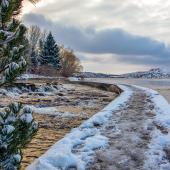Reading Comprehension
How river dynamics affect habitat.
Reading the water describes one’s ability to look at the water and know where the fish are—or should be, anyway. Viewing a stretch of river, anglers with extensive experience read the water without even thinking much about it, quickly ruling out water that is less likely to hold good fish. Newer anglers, however, often have trouble deciding where to cast or understanding why one spot is better than another. As the saying goes, 10 percent of the anglers catch 90 percent of the fish. Learning how to better read the water improves your odds.
While trout species have different needs and preferences, they all require the same essentials for survival. Clean, cool, and well-oxygenated water is critical. Safety from predation, availability of food, and the balance of energy consumed versus energy expended are all important survival factors that the angler should consider before casting a fly.
Trout prefer to hold in water that is slower, with faster water directly adjacent to them. The faster water carries the food to them, and holding on the slower side allows them to conserve energy between meals. Look for seams where the water speeds up as it passes an obstruction such as a large rock, tree limb, gravel bar, or weedbeds. Although the area directly behind these obstructions is often productive, don’t forget to fish the areas directly in front of them, as well. There’s a buffer on the upstream side of the obstruction that can provide trout with a calm holding spot. Seams can sometimes be found by observing bubbles or foam traveling in a linear orientation downstream. Insects will often become concentrated by the currents into these foam lines and the trout take full advantage of it.
A change in river depth can also produce great holding water. To find these areas, you’ll want to look for a color change in the water or a smoother area on the surface formed by the water deepening. These depressions or “buckets” are prevalent on rivers like the Lower Madison and can save the day when all else fails. When dry-fly fishing, presentation should be made by casting above the bucket and letting the fly pass over. When fishing nymphs or streamers, let the fly drop into the bucket.
Cut-banks are another essential structure one should learn to identify. Recalling the trout’s need for protection from predators, banks provide perfect hiding spots. A trout can hide its entire body under a cut-bank waiting to ambush a fly or a smaller fish. Fishing terrestrials like hoppers and ants along the bank in the summer and fall is effective.
Keep your eyes open and practice reading water every time you see a stream. In time, you’ll get to know where the trout hide and have greater success coaxing them out.
Matt Rosenthal owns the Bozeman Family Fly Shop. A biologist by education, Matt has a keen interest in entomology, fly tying, and teaching folks to fly fish.











